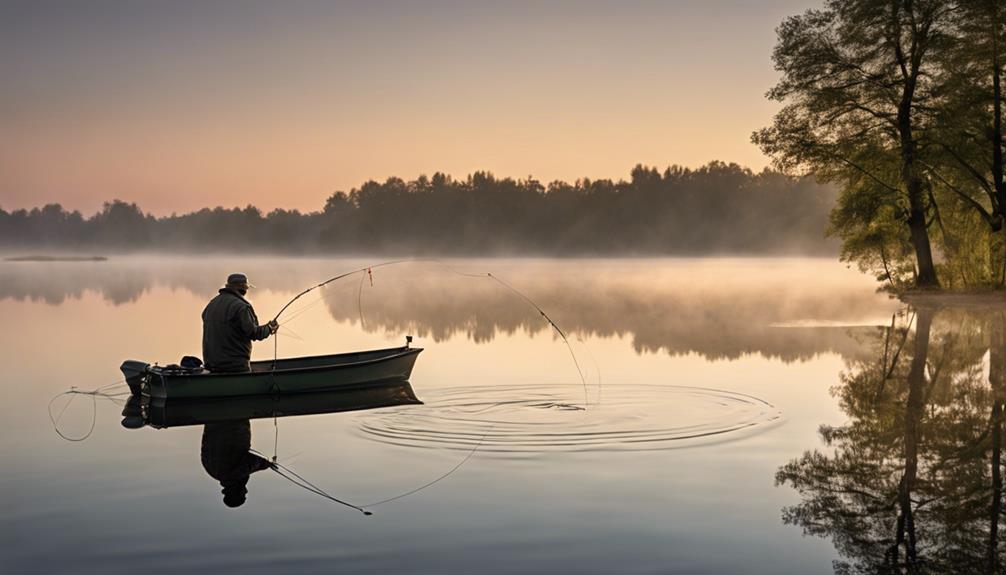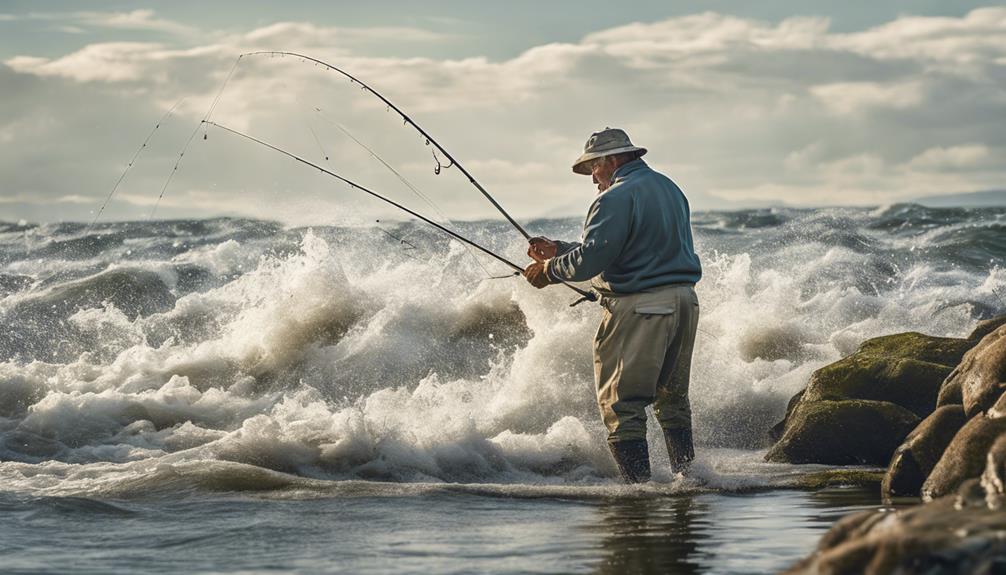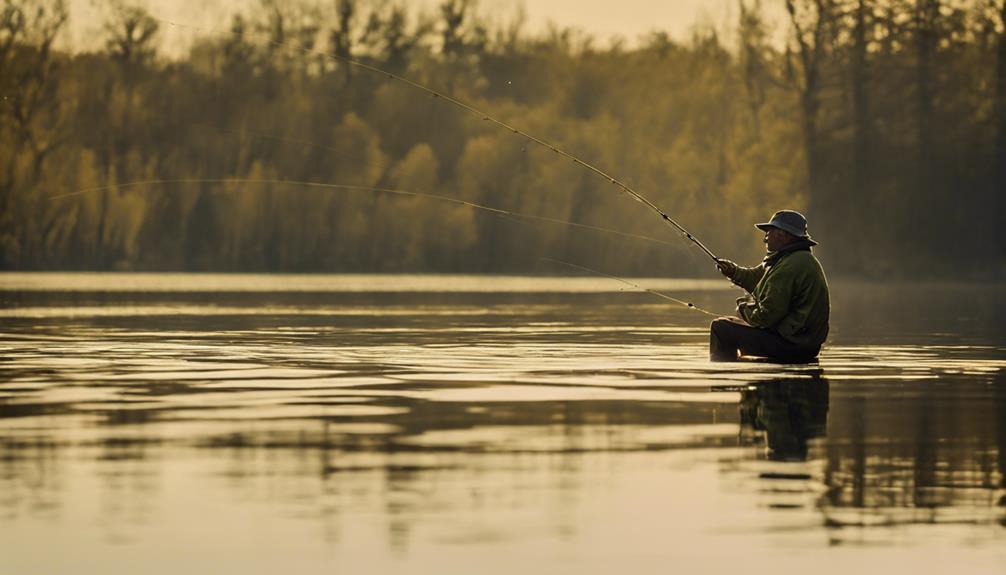When it comes to fishing for sharks, it's like navigating through a vast ocean of possibilities. The techniques used for different species vary, each requiring a unique approach and skill set.
Imagine yourself on the edge of your seat, ready to discover the top three strategies that will give you the upper hand in reeling in these mighty predators. Whether you're after the powerful Great White, the elusive Hammerhead, or the ferocious Tiger Shark, mastering these techniques could mean the difference between a thrilling catch and a missed opportunity.
Great White Shark Fishing Techniques
Mastering the art of luring and capturing Great White Sharks requires skill, patience, and precision. When engaging in cage diving, safety precautions are paramount. Ensuring that the cage is sturdy and secure will protect both you and the sharks during the encounter. It's essential to follow all guidelines provided by experienced professionals to guarantee a safe and successful dive.
Tagging is a crucial aspect of researching Great White Sharks. By tagging these majestic creatures, scientists can track their movements, behaviors, and migration patterns. When tagging a Great White Shark, precision is key. Carefully approaching the shark and attaching the tag swiftly and accurately is vital for the success of the research. This method provides valuable insights into the lives of these apex predators, aiding in conservation efforts and enhancing our understanding of their ecological role.
To master the art of luring and capturing Great White Sharks, it's essential to approach the task with respect for these animals and a deep understanding of their behavior. By following safety precautions during cage diving and employing precise tagging techniques, you can contribute to ongoing research efforts and help protect these magnificent creatures for generations to come.
Tiger Shark Fishing Techniques
When shifting focus to Tiger Shark fishing techniques, understanding the unique behaviors and characteristics of these powerful predators is crucial for successful encounters. Tiger Sharks are known for their voracious appetite and aggressive feeding habits, making bait selection a key factor in attracting them. Opt for fresh and oily bait such as mullet, mackerel, or bonito to entice Tiger Sharks effectively.
In terms of rod positioning, it's vital to set up your gear with sturdy equipment that can withstand the strength of a Tiger Shark. Position your rod securely in a rod holder to prevent the shark from easily dragging it into the depths once hooked. Additionally, using a heavy-duty rod and reel combo will give you better control during the fight.
Chumming tactics play a significant role in Tiger Shark fishing. Implement a steady chum slick using chunks of baitfish to create a scent trail that will lead the sharks to your fishing spot. This method can increase your chances of attracting Tiger Sharks to your baited lines.
When it comes to hook size, opt for a large and durable hook to handle the powerful jaws of a Tiger Shark. A 9/0 to 12/0 circle hook is recommended to ensure a secure hookset once the shark takes the bait. By considering these bait selection, rod positioning, chumming tactics, and hook size tips, you can enhance your Tiger Shark fishing experience and increase your chances of a successful catch.
Hammerhead Shark Fishing Techniques
To effectively target Hammerhead Sharks, utilize specialized fishing techniques tailored to their distinct behaviors and habitat preferences. When it comes to bait selection, Hammerhead Sharks are known to be attracted to fresh and oily baits such as bonito, mackerel, or even squid. These strong-smelling baits can help lure Hammerheads to your fishing spot. In terms of rod action, using heavy-duty tackle with a strong rod and reel is crucial when targeting Hammerheads due to their size and strength. Make sure your gear is up to the task to handle these powerful creatures.
Location scouting plays a significant role in Hammerhead Shark fishing. Look for areas with a high population of Stingrays, one of their favorite prey, as Hammerheads often patrol these areas in search of food. Additionally, shallow coastal waters near drop-offs and ledges are prime spots for encountering Hammerheads. Time management is key when targeting Hammerheads, as they're more active during dawn and dusk when they're feeding. Plan your fishing trips accordingly to increase your chances of a successful catch.
Bull Shark Fishing Techniques
For targeting Bull Sharks effectively, consider adjusting your gear and bait choices to match their predatory behavior and habitat preferences. Bull sharks are known for their opportunistic feeding habits and diverse diet, which includes fish, rays, turtles, dolphins, and even other sharks. When fishing for Bull Sharks, using fresh chunks of these types of prey as bait can increase your chances of a successful catch.
To aid in conservation efforts and research, some anglers participate in Bull shark tagging methods. Tagging these sharks allows scientists to track their movements, behavior, and population dynamics, contributing valuable data to their conservation. If you're interested in tagging Bull Sharks, make sure to follow proper tagging protocols to ensure the shark's safety and well-being.
In terms of gear, using heavy-duty tackle is essential when targeting Bull Sharks due to their size and strength. A sturdy rod and reel with a high-quality drag system are recommended to handle the fight these powerful sharks put up. Additionally, using steel leaders to prevent bite-offs is crucial, as Bull Sharks have sharp teeth that can easily cut through traditional fishing lines.
Mako Shark Fishing Techniques
Consider using specialized gear and techniques for targeting Mako Sharks to maximize your chances of a successful catch. When it comes to Mako shark baiting strategies, it's crucial to use fresh and oily baits such as bonito, mackerel, or tuna to attract these fast and powerful predators. Mako sharks are known for their incredible speed and acrobatics, so it's essential to have the right setup to handle their strength.
For the best tackle for mako shark fishing, opt for heavy-duty gear that can withstand the fight of a Mako. A sturdy rod and reel with a high line capacity, preferably a lever drag reel paired with a strong rod, will give you the power needed to reel in these formidable creatures. Consider using wire leaders to prevent bite-offs from their razor-sharp teeth, as Mako sharks are known to bite through traditional monofilament or fluorocarbon leaders.
When targeting Makos, it's essential to be prepared for a high-energy battle. These sharks are known for their long runs and impressive leaps, so staying focused and maintaining a strong stance is key to a successful catch. By following these mako shark baiting strategies and using the best tackle available, you'll be well-equipped to tackle the challenge of landing one of the ocean's most thrilling predators.
Thresher Shark Fishing Techniques
Using specialized gear and precise techniques can significantly enhance your chances of successfully catching Thresher Sharks. When targeting Thresher Sharks, it's essential to be mindful of thresher shark conservation efforts. These sharks are vulnerable to overfishing, making it crucial to handle them with care and release them properly if not intended for consumption.
One important aspect of Thresher Shark fishing is thresher shark tagging. By participating in tagging programs, you can contribute valuable data to scientific research and help monitor Thresher Shark populations. When fishing for Thresher Sharks, ensure you're equipped with the necessary tagging equipment and follow the proper procedures for tagging and releasing the sharks.
Thresher Sharks are known for their long, whip-like tails that they use to stun their prey. When fishing for Thresher Sharks, it's important to use strong and reliable tackle to handle their powerful fighting abilities. Consider using heavy-duty rods and reels, sturdy hooks, and strong lines to withstand the strength of these predators.
Nurse Shark Fishing Techniques

Have you ever wondered about the most effective techniques for catching Nurse Sharks? Nurse Sharks are known for their bottom-dwelling nature and can often be found in shallow waters near reefs, making them a popular target for anglers. When it comes to catching these docile creatures, there are a few key tips to keep in mind that can help increase your chances of a successful catch.
First and foremost, bait selection plays a crucial role in attracting Nurse Sharks. These sharks are scavengers and are attracted to strong scents, so using oily or bloody fish such as mackerel, bonito, or barracuda can be highly effective. Freshness is also key, as Nurse Sharks are more likely to be enticed by bait that's still releasing strong odors into the water.
In terms of catching tips, one effective technique is bottom fishing. Nurse Sharks are bottom feeders, so presenting your bait near the ocean floor can increase the likelihood of a bite. Using heavy tackle is recommended, as Nurse Sharks are strong and can put up a good fight once hooked. Additionally, keeping a steady tension on the line and allowing the shark to tire itself out before attempting to reel it in can help prevent it from breaking free.
Blue Shark Fishing Techniques
When targeting Blue Sharks, employing drift fishing can be a highly effective technique to increase your chances of a successful catch. Blue Sharks are known to be attracted to movement in the water, making drift fishing an ideal method to entice them.
To optimize your blue shark fishing experience, consider the following tips:
- Bait selection: Blue Sharks are known to be opportunistic feeders, so using fresh and oily baits like mackerel, squid, or bonito can be highly effective in attracting them.
- Rod type: Opt for a sturdy and reliable heavy-duty rod that can withstand the strength and fight of a blue shark once hooked. A rod with a good backbone and sensitive tip is crucial for successful hook sets.
- Line strength: Use a heavy braided line with a high breaking strength to handle the powerful runs and sharp teeth of blue sharks. A line strength of at least 50-80 pounds is recommended for this type of fishing.
- Hook size: When targeting blue sharks, opt for large circle hooks in the range of 10/0 to 16/0 to ensure a secure hookset. Circle hooks are preferred for their ability to hook the shark in the corner of the mouth, reducing the risk of gut hooking and aiding in a safe release.
Frequently Asked Questions
Are There Any Specific Regulations or Restrictions for Shark Fishing in Different Regions?
In different regions, regulations and restrictions for shark fishing vary. Enforcement is key to ensuring conservation and sustainability. Proper management and monitoring help protect shark populations.
Check local guidelines to understand specific rules in your area. Be aware of size limits, catch quotas, and prohibited species. Stay informed and follow regulations to help preserve shark populations for future generations.
What Are Some Common Mistakes to Avoid When Shark Fishing?
When shark fishing, avoiding common mistakes like using improper gear or techniques is crucial. Always handle sharks properly to ensure their safety and yours. Remember to respect regulations and guidelines to protect shark populations.
Proper handling techniques include using circle hooks, avoiding dragging sharks onto the boat, and releasing them quickly and safely. By being mindful of these factors, you can enjoy shark fishing responsibly and sustainably.
How Can Anglers Best Ensure the Safety of Both Themselves and the Sharks During the Fishing Process?
When fishing for sharks, remember safety precautions for yourself and the sharks. Practice conservation efforts by using barbless hooks and proper handling techniques.
Avoid harming the sharks or endangering yourself by following guidelines on safe catch and release methods. Always prioritize safety and respect for these magnificent creatures to ensure a positive fishing experience for both you and the sharks.
Are There Any Environmental Concerns Associated With Shark Fishing That Anglers Should Be Aware Of?
When shark fishing, it's crucial to consider the impact on ecosystems. Your actions can affect the balance of marine life.
Conservation efforts are key in protecting shark populations. Be mindful of environmental concerns like overfishing and habitat destruction.
What Are Some Alternative Methods or Techniques for Catching Sharks That Do Not Involve Traditional Fishing Practices?
When it comes to catching sharks without harming them, conservation methods and sustainable practices are key. Non-lethal techniques like catch and release can help protect shark populations.
Conclusion
Now that you have learned the best fishing techniques for various shark species, you're ready to hit the waters and test out your skills.
Remember to always prioritize safety and conservation when fishing for sharks, and respect these incredible creatures in their natural habitat.
With the right techniques and mindset, you can have a thrilling and successful shark fishing experience.
Good luck out there!



